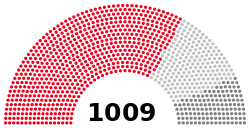Italian presidential election, 2015
|
|
||||||||||||||||||||
|---|---|---|---|---|---|---|---|---|---|---|---|---|---|---|---|---|---|---|---|---|
|
||||||||||||||||||||
|
1009 voters: 315 Senators, 6 Senators for life, 630 Deputies and 58 regional representatives 673 or 505 votes needed to win |
||||||||||||||||||||
|
||||||||||||||||||||

Composition
Mattarella 665 Others 212 Invalids, blanks 132 |
||||||||||||||||||||
|
||||||||||||||||||||
Mattarella 665 Others 212
The Italian presidential election of 2015 was held in Italy on 29–31 January 2015, following the resignation of incumbent President Giorgio Napolitano on 14 January 2015. Only members of Parliament and regional delegates are entitled to vote. As head of state of the Italian Republic, the President has a role of representation of national unity and guarantees that Italian politics comply with the Italian Constitution, in the framework of a parliamentary system.
On 31 January, at the fourth round of voting, Constitutional Court judge Sergio Mattarella was elected President with 665 votes out of 1,009.
In accordance with the Italian Constitution, the election is held in the form of a secret ballot, with the Senators, the Deputies and 58 regional representatives entitled to vote. The election is held in the Palazzo Montecitorio, home of the Chamber of Deputies, with the capacity of the assembly room expanded for the purpose. The first three ballots require a two-thirds majority of the 1,009 voters in order to elect a President, or 673 votes. Starting from the fourth ballot, an absolute majority is required for candidates to be elected, or 505 votes. The presidential mandate lasts seven years.
...
Wikipedia


